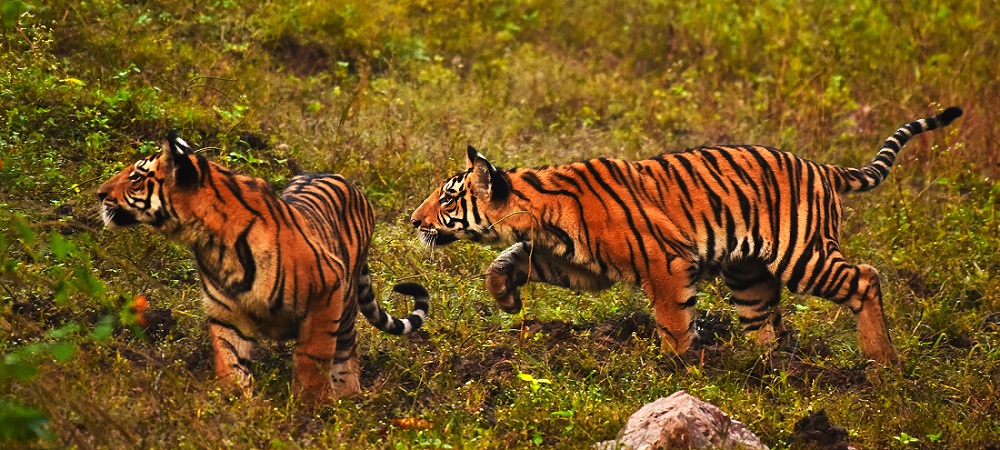Pench National Park indeed holds a special place in the hearts of wildlife enthusiasts especially those passionate about tiger protection and exploration. Situated in the southern reaches of Madhya Pradesh, Pench is renowned for its rich biodiversity and captivating landscapes. It served as the inspiration for Rudyard Kipling's "The Jungle Book," owing to its dense forests and diverse wildlife. One of the park's highlights is its healthy population of Bengal tigers, which roam freely in its forests. Visitors often embark on safaris through Pench's rugged terrain hoping for a glimpse of these majestic creatures in their natural habitat. Apart from tigers, Pench is home to a variety of other wildlife species, including leopards, sloth bears, wild dogs and numerous species of birds. The park's topography consists of teak forests, open grasslands and meandering streams, creating an ideal habitat for its diverse flora and fauna. Exploring Pench is not just about spotting wildlife but also about immersing oneself in the serenity of nature, surrounded by the sights and sounds of the wilderness.
Early history of Pench National Park
The early history of Pench National Park is deeply intertwined with its rich natural heritage and the cultural tapestry of the region. The Pench region has a history dating back to ancient times with evidence of human habitation and activities found in and around the area. The forests of Pench have likely been home to indigenous tribes and early settlers who relied on its resources for sustenance. During the colonial period, the forests of Pench were exploited for timber and other resources by the British. The area was under the administration of the Central Provinces, a British-administered province in central India. The exploitation of natural resources during this period led to environmental degradation and loss of wildlife habitats. Pench Sanctuary was established in 1977, primarily to protect the area's tiger population. It initially comprised a smaller area and was later expanded to encompass a larger tract of land. The sanctuary was named after the Pench River, which flows through the region forming a lifeline for the diverse ecosystems within. In 1983, Pench Sanctuary was upgraded to the status of a national park, becoming Pench National Park. This upgrade aimed to provide enhanced protection to the park's biodiversity and promote ecotourism in the region. The park's boundaries were further expanded, encompassing more contiguous forest areas.
Ecological diversity of Pench National Park
Pench National Park is renowned for its remarkable ecological diversity which encompasses a variety of habitats supporting an abundance of flora and fauna. Pench National Park is predominantly characterized by tropical dry deciduous forests which consist of a mix of tree species such as teak, mahua, tendu, salai and many others. These forests provide essential habitat for a wide range of wildlife, including large mammals, birds, reptiles and insects. Interwoven within the forested areas are expansive grasslands and meadows, offering grazing grounds for herbivores like spotted deer, sambar deer, barking deer and nilgai. These open spaces also serve as hunting grounds for predators such as tigers, leopards, and wild dogs. The Pench River and its tributaries flow through the park, creating vital riverine ecosystems that support diverse aquatic life, including fish, amphibians and reptiles. These water sources are essential for the survival of wildlife during the dry season and provide a picturesque backdrop for the park's landscape. Apart from the main river, Pench National Park is dotted with numerous water bodies such as ponds, lakes and marshes.
Jeep Safari-Related Things to Know for Pench National Park
• Ensure you obtain the necessary permits for entering the national park and booking your jeep safari in Pench in advance. Permits can usually be obtained through our official website of the park or by speaking to our booking associates.
• Jeep safaris in Pench National Park are conducted in two shifts - morning and afternoon. The timings may vary depending on the season, so it's advisable to check the schedule in advance and plan your safari accordingly.
• The duration of a jeep safari typically ranges from 3 to 4 hours including the entry and exit from the park. Make sure you arrive at the designated entry gate on time to avoid any delays.
• Each jeep safari vehicle has a limited seating capacity usually accommodating up to 6 passengers along with a guide and driver. It is very much essential to book your safari in advance to secure your spot on the vehicle.
• A trained naturalist or guide accompanies every jeep safari to provide valuable insights into the park's wildlife, flora and fauna. Listen to their instructions and guidelines for a safe and informative safari experience.
• Follow all safety regulations and guidelines provided by the park authorities. Stay inside the vehicle at all times and refrain from standing up or making sudden movements that may disturb the wildlife.

